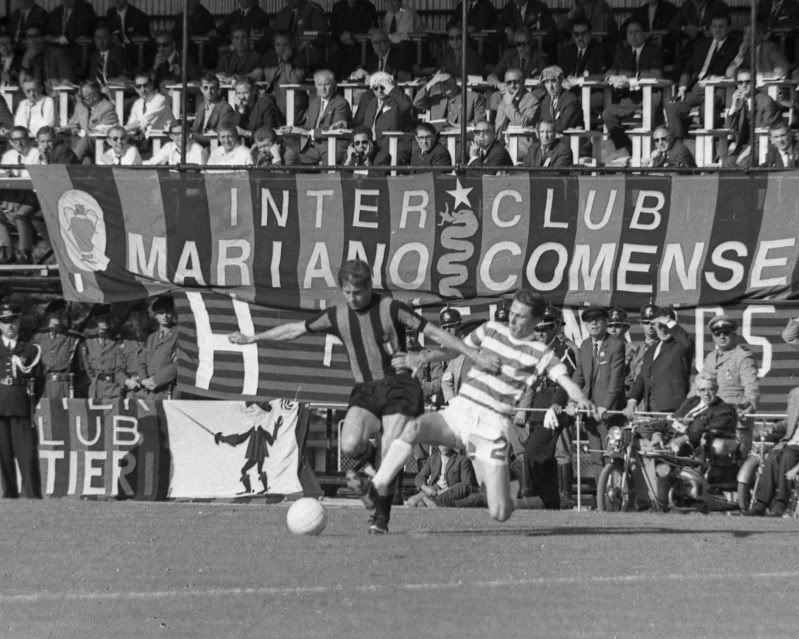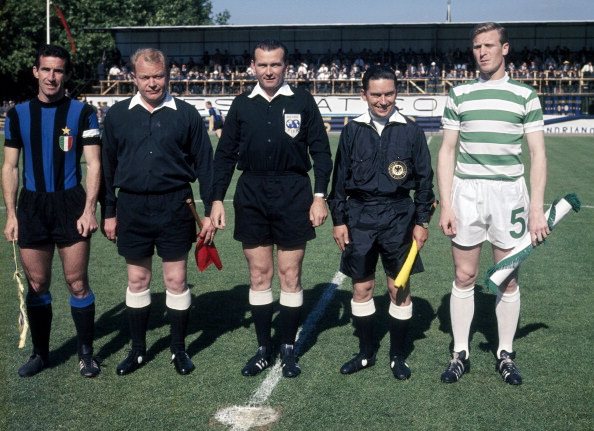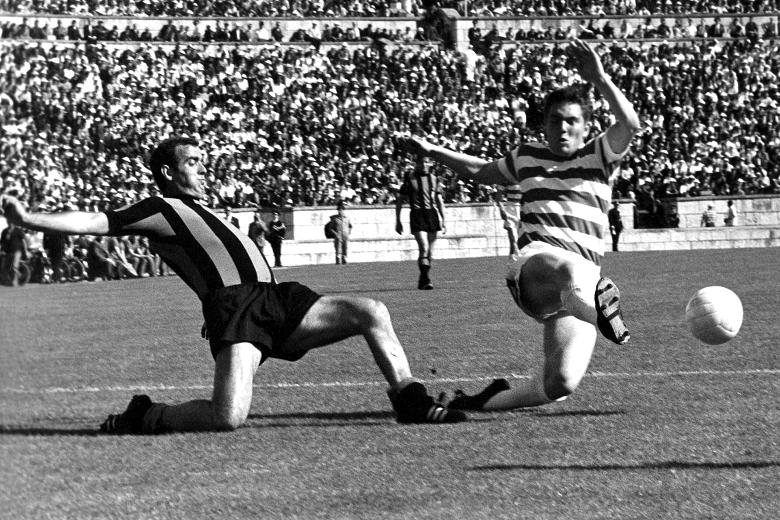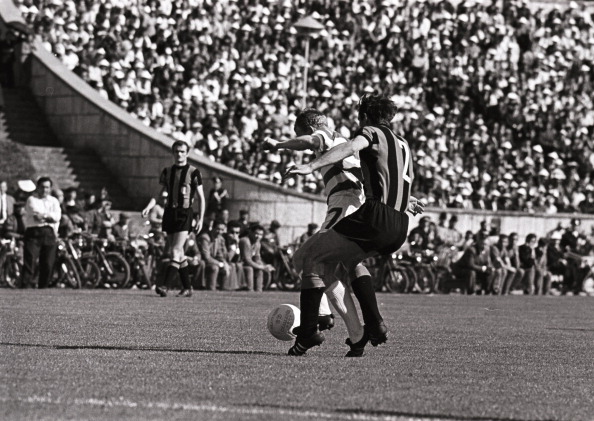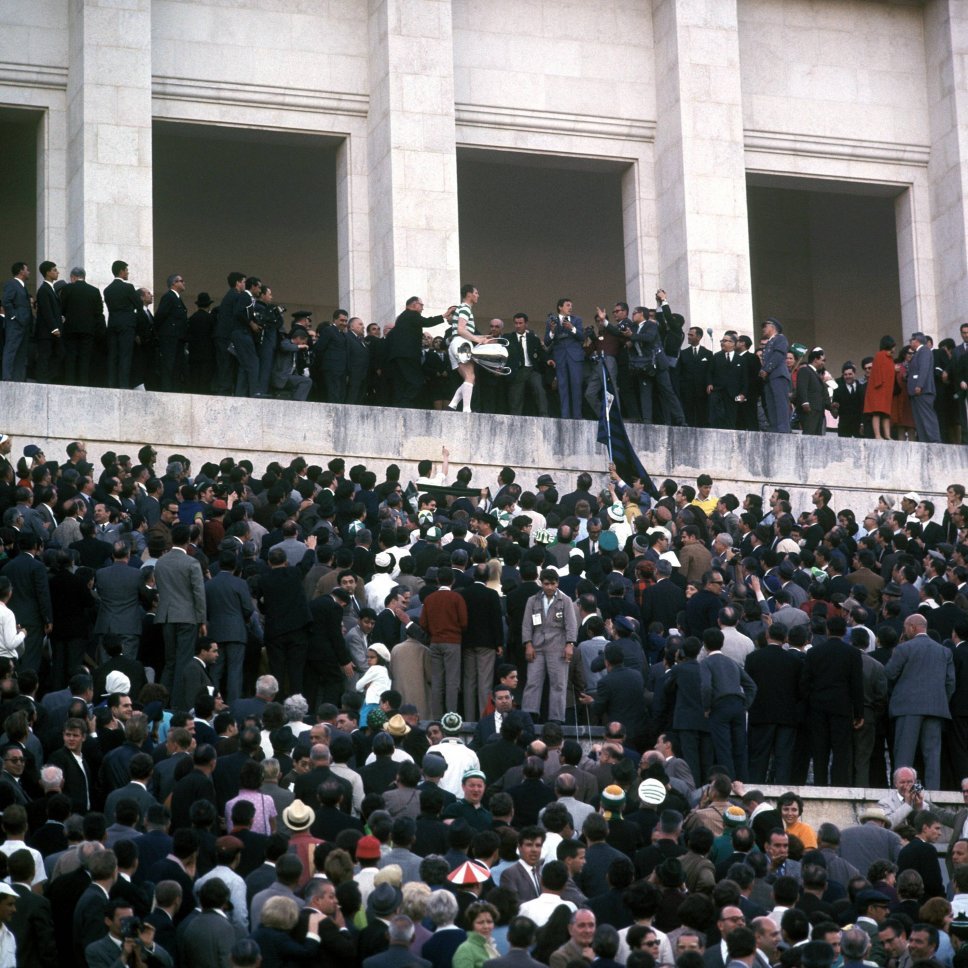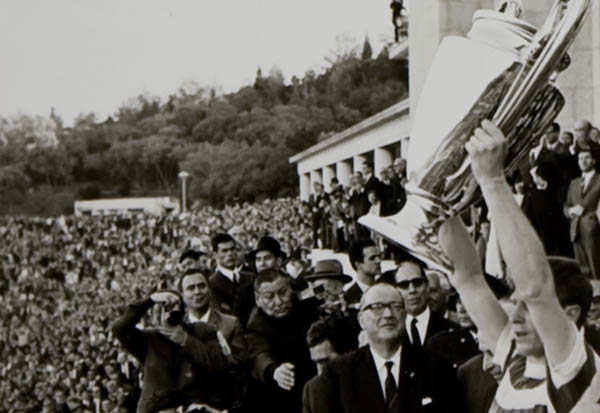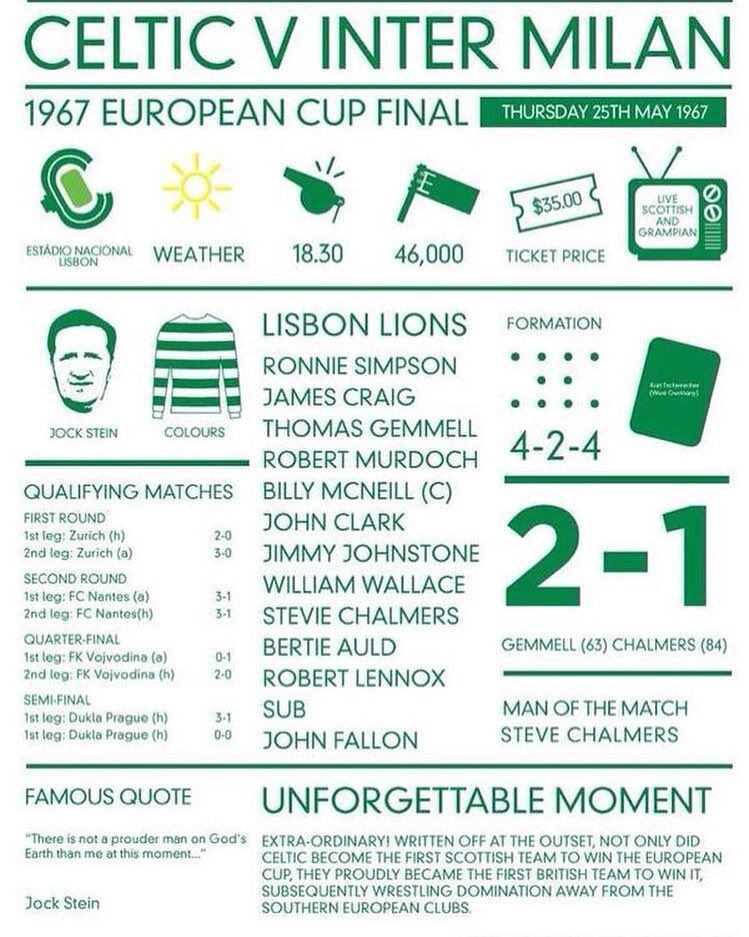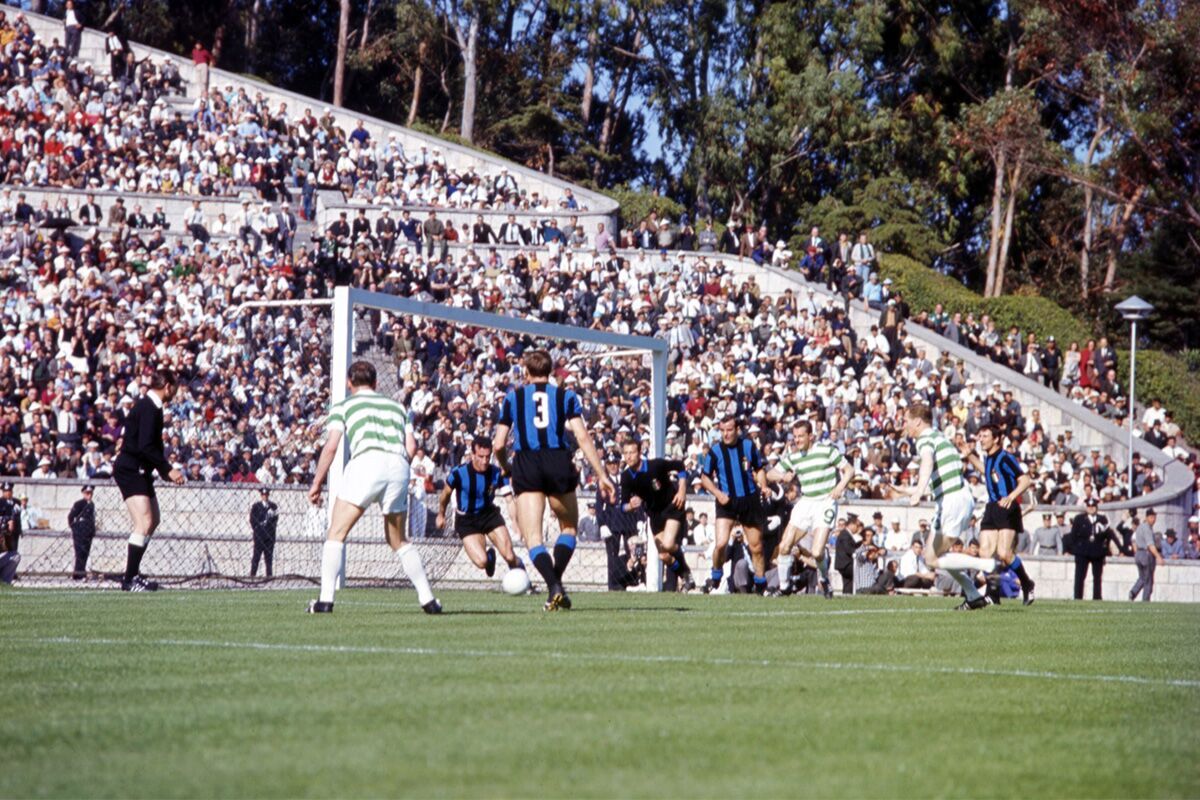The Valencia file – In the heat of Lisbon, the pupils become the masters…
Four days after the victory in Prague, Celtic took another huge step towards a unique, historic season, defeating Aberdeen at Hampden, in the Scottish Cup Final, in front of 126,000 fans. Hero of the hour was again Willie Wallace, with both goals, following up on his brace against Dukla. His £30,000 fee was already looking money well spent, particularly given the continued absence of the prolific Joe McBride.
Their opponents in the forthcoming European Cup Final were still not known, the second leg of the tie in Sofia between CSKA and Inter Milan had finished 1-1, just as the first game in the San Siro had, one week earlier. With the teams unable to be split on the ‘away goal’ basis, a Play-off would be required.
Here are some highlights from the game at the San Siro.
And from the first-leg match in Sofia.
On 3 May 1967, the teams met for a third time, Bologna’s Stadio Renato Dall’Ara the venue chosen, the majority of the 30,000 crowd cheering on the Italians. There would be only goal this time around, Inter’s international striker, Cappellini, finally settling the outcome with his twelfth-minute winner.
So it was official. The European Cup Final would be played between Celtic, eleven Scots playing in the competition for the first time, and Internazionale, the millionaire superstars who had won two of the last three European and World Club titles. In the heat of Lisbon in late May. Men against Bhoys, surely?
The Final had actually been brought forward from its originally-scheduled date of Wednesday 31 May and would now be played the preceding Thursday, in Lisbon’s Estadio Nacional, normally reserved for the Portuguese Cup Final and international matches.
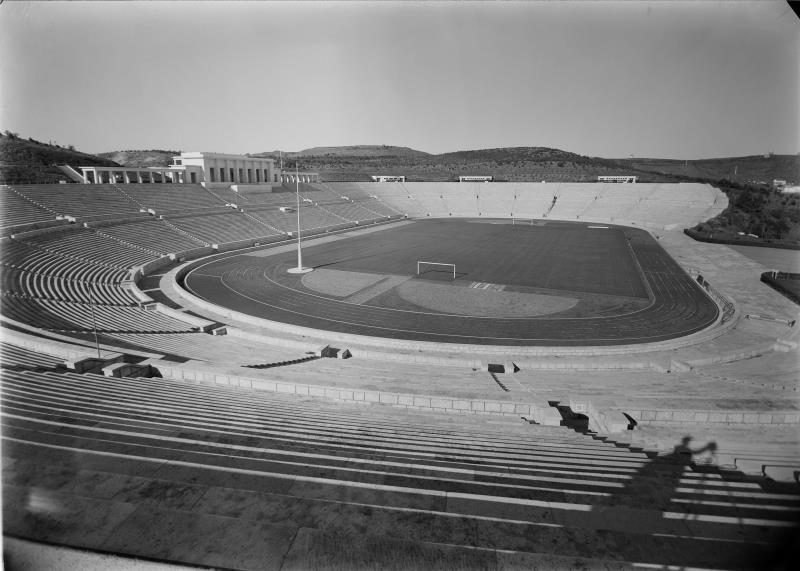
Local side Benfica had won the old Cup twice, in 1961 and 1962, ending the five-year run of Real Madrid. The Spaniards had won a sixth title last year, beating Partizan Belgrade, an achievement recognised by UEFA, who allowed them to retain the original trophy permanently. The first European Cup Final to be held in Portugal would see the award of a brand new European Cup. The firsts were lining up for Celtic. It was meant to be, it just was.
On the Saturday after Inter were confirmed as the last hurdle on the Road to Lisbon, Celtic had an important domestic date. As the Italians were winning in Bologna, the Bhoys had lost their unbeaten home record to Dundee United, by the same 3-2 margin as Jerry Kerr’s side had inflicted a first defeat of the season at Tannadice on Hogmanay. The football gods work in mysterious ways, sometimes. More importantly, Celtic had failed to gain the point required to clinch a second successive League title. The next opportunity would be at Ibrox, the home of their great rivals, the following Saturday.
Despite the Glasgow downpour, 78,000 fans packed into the ground to watch a fixture postponed from Ne-erday. The second and final League fixture between the sides would traditionally take place in early January, thus a League decider between Celtic and Rangers was something of a rarity. Four meetings per season and the unpredictable weather would combine to make this more common in the decades ahead. There was at least one neutral face in the crowd, Inter manager, Helenio Herrera.

Celtic’s league record in Govan was hardly inspiring, no wins there since September 1957, the month before Hampden in the Sun. But Stein’s men had history in their sights. The game ebbed and flowed on the muddy surface before exploding, just on the interval.
First the late Sandy Jardine, still plain Billy at that time, cracked a ferocious drive past Simpson off the underside of the bar, to give the hosts the lead they craved. It would last less than a minute, Johnstone the first to react as Lennox’s shot came back off a post, the little winger bundling it home. With fifteen minutes remaining, Jinky secured the title with a goal of breathtaking brilliance, cutting across the defence to smash a left-foot rocket high past the helpless Martin in the Rangers goal, the ball sticking in the mud in a moment captured forever. Hynd would equalise for the Ibrox side in the closing minutes but the day belonged to Johnstone and Celtic. The domestic treble secured, the Glasgow Cup there too for good measure. It was Lisbon time.

To win the European Cup in Lisbon, Jock Stein and Celtic would have to overcome yet another master. Helenio Herrera was born in Buenos Aires in 1910 but first came to prominence forty years later, when his Atletico Madrid side won the first of two consecutive La Ligas. He would repeat that feat towards the end of the decade with Barcelona, also winning the first-ever Inter-Cities Fairs Cup in 1958, beating a London XI 6-0 in the Camp Nou.
Barcelona would retain the title in 1960, the competition stretching over two seasons, however, Herrera had been dismissed before the second-leg victory over Birmingham City, following a 6-2 aggregate defeat in the European Cup Semi-final to bitter rivals Real Madrid. A series of public feuds with star player and fans’ favourite, Laszlo Kubala, did not help him.
Herrera moved to Inter Milan, taking Spanish playmaker, Luis Suarez, with him soon afterwards in a world-record transfer. He would raise his profile remarkably over the next decade. Creating La Grande Inter, he would lead them to three Serie A titles, two European Cups and two World Club Championships, his defensive 5-3-2 ‘catenaccio’ approach setting the tone and standard for European football for the first half of that decade.
In the interests of balance, Herrera argued vehemently that people failed to recognise the role of attacking full-backs, such as Facchetti, in his model. Given the great man’s scoring record, examples to follow, it would be fair to say he perhaps had a point.
His first venture into the European Cup with Inter commenced with a goalless draw at Goodison Park in September 1963, against English champions, Everton. True to form, a solitary Jair strike at the San Siro settled the tie. Further wins over Monaco, Partizan Belgrade and Borussia Dortmund saw the ‘Nerazzurri’ reach their first Final, where they would face Real Madrid in Vienna.

There were over 70,000 in the Prater, to see the old masters, Puskas, Di Stefano and Gento, take on Herrera’s young pretenders. Mazzola broke the deadlock, just before the interval, with a tremendous shot from outside the box. Strike partner, the aptly-named Milani, added a second on the hour, with a low drive which goalkeeper, Vicente, should surely have held. Felo pulled a goal back for the Spaniards, with twenty minutes remaining, hooking the ball home following a corner. But five minutes later, Mazzola had the last word, benefiting from a Santamaria error to fire home and win the Cup for Inter.
Sandro Mazzola was already on his way to becoming a legend of Internazionale and Italy. His early life had been tinged with sadness and tragedy, his parents divorcing when he was four years old then his father, Torino and Italy striker, Valentino, who was bringing Sandro up, being killed in the Superga air disaster with his team-mates three years later, aged just 30.
Mazzola junior would go on to emulate his father’s achievements, winning medals galore in a 17-year, one-club career. He played in three World Cup Finals tournaments between 1966 and 1974, losing the 1970 Final to ‘Team of the Century’, Brazil, Pele at al. Two years earlier, he had been part of the Italian side who won their home Nations Cup, beating Yugoslavia in the replayed Final. Mazzola was named in the Team of the Tournament.
There was a lovely gesture after that first European Cup Final in Vienna, when the great Puskas approached Sandro to present him with his shirt, advising that he had played against Valentino and that his son had did him proud. Occasionally we are gently reminded why we love football so much.
The European Cup triumph set up a September clash with Independiente of Argentina, for the title of World Club Champions. A single-goal defeat in Avellaneda was ‘matched’ by a 2-0 victory in the San Siro. The unusual rule, where results rather than scores counted, i.e. one win apiece, meant a Play-off was required. This took place in the Santiago Bernabeu, three days later, an extra-time Corso goal winning the day for the Italians.
Herrera’s Inter began the defence of their European Cup against Dinamo Bucharest with a 6-0 mauling in Milan. Strangely, by this time they were no longer champions of Italy, having lost a title Play-off to Bologna in Rome, the only time this has happened in Serie A history.
With Bologna eliminated at the first Euro hurdle by Anderlecht, on the toss of a coin, the Nerazzurri continued to fly the Tricolore for Italy, knocking out Rangers by the odd goal in five then recovering from a 3-1 defeat at Anfield to hit three without reply at the San Siro, the great Facchetti with the Semi-final clincher. Inter then had the opportunity to win their second successive European Cup on their own ground, Eusebio and Benfica standing in their way.
Nearly 80,000 were crammed into the stadium, as Brazilian Jair hit the only goal of the game, just before the interval, goalkeeper Costa Pereira letting his shot squirm past him. Inter thus emulated Real Madrid in 1957, by winning Europe’s premier tournament on home soil. No-one has managed to repeat this since, although both Roma and Bayern have lost Finals in that situation.
It was ‘same again, Lorenzo’ as the European Champions faced their South American equivalents in the 1965 Inter-Continental Cup. Independiente were again the opposition, beaten 3-0 in the first-leg at the San Siro, thanks to Peiro and a Mazzola brace. Inter managed a scoreless draw in Argentina, to retain their trophy, achieving a rare ‘double double’ of European and World crowns in the process.
There was also a sense of deja-vu as the 1965/66 European campaign kicked off, Dinamo Bucharest again the First Round opposition. This time around would be a much closer affair, Inter edging it 3-2 with a Mazzola penalty and a late Facchetti goal, after defeat in Romania.
The Quarter-final tie saw Hungarian champions, Ferencvaros, suffer a 4-0 loss in Milan, the second-leg ending 1-1. In the Last Four, there was a replay of the Prater Final two years earlier, however, on this occasion, Madrid would have the edge, a Pirri goal enough for victory at the Bernabeu, a late Facchetti equaliser in the San Siro not enough to save Inter, after Amancio’s opener.
Real would go on to win a sixth European Cup, beating Partizan Belgrade 2-1 in Brussels. The Yugoslavs had been the surprise Semi-final conquerors of Manchester United, as Matt Busby’s European dream was pushed back for at least another year.
With the domestic title of 65/66 again retained, there would be a fourth successive European Cup campaign for Herrera and Inter. This season, Lisbon would be the goal. For the first time, the Soviet Union had entered their champions, the draw sending Torpedo Moscow to Milan, in a baptism of fire. An own goal from Soviet midfielder, Voronin, on the hour would prove the only score of the tie. Vasas were dispatched with more ease in the next round, wins for the Italians in both Milan and Budapest.
The Quarter-final threw those two old rivals together for the third time in four seasons, Inter winning the ‘best of three’ by defeating Real Madrid in both legs. Classed by many as ‘the final before the final’, this result would directly impact on the history of Celtic. First, there would be the small matter of a Last Four tie with CSKA Sofia, the tie going to a Play-off, after two 1-1 draws, as discussed earlier, the Italians finally winning through in Bologna.

So in the heat of Lisbon, the fans came in their thousands, many travelling abroad by whichever means. The 45,000 crowd in Lisbon’s Estadio Nacional was made up mostly of Celtic supporters and locals, many wearing the red-and-white or green-and-white ‘chinese-style’ sunhats, colour depending on whether you were ‘Benfica or Sporting’. Tonight, most neutrals are ‘Celtic’.
There is a pre-match boost for Celtic, as Luis Suarez, the Spanish playmaker who has been with Herrera every step of the way since Barcelona in the late 50s, has not passed a fitness test. Like Celtic and McBride, Inter will be missing a key player when the action gets underway.
The pre-match games have kicked in, both on the pitch as Stein ‘claimed’ Herrera’s bench and down in the tunnel, as Bertie and the Bhoys belted out the Celtic song, to the quiet amusement of their Italian opponents. They would not be smiling for long once the game had started.
In the most offensive display of attacking football witnessed for years, if not all time, Celts went on the attack from the first whistle. There is a horror moment on seven minutes, Craig felling Cappellini to concede a penalty, Mazzola sending Simpson one way and the ball the other, the worst possible start for Celtic.
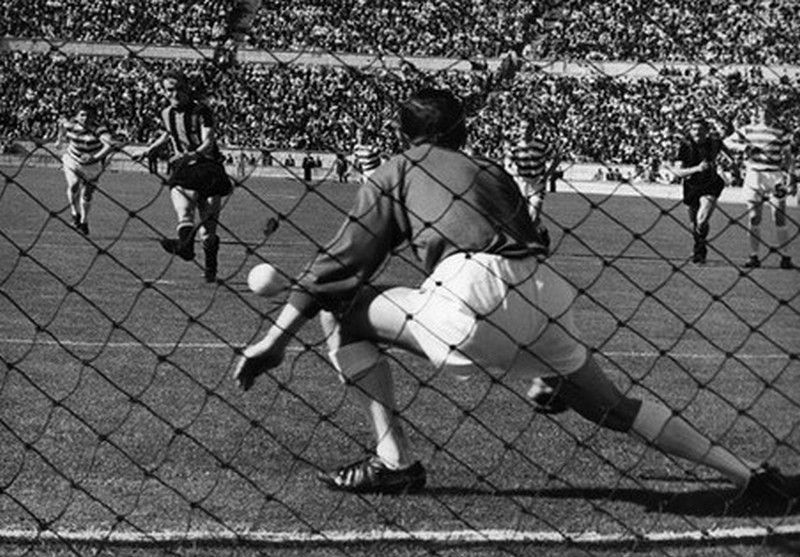
But back they came in waves, Sarti producing a goalkeeping display par excellence and the woodwork doing its job as the shots rain in. There is a second scare as the one-way traffic abates for a moment, Simpson facing his own goal with the riskiest of back-heels as Inter close him down…and breathe.
At half-time, Celts are still a goal down but not disheartened. Then on the hour, comes the goal which will change the course of Celtic’s history forever. Craig, yet again advancing down the right wing and pulling the ball back, urging the shot. This time it’s his full-back colleague, Gemmell, who is first to the ball, meeting it with an almighty smack just outside the box, to send it flying past Sarti. 1-1. Game on.
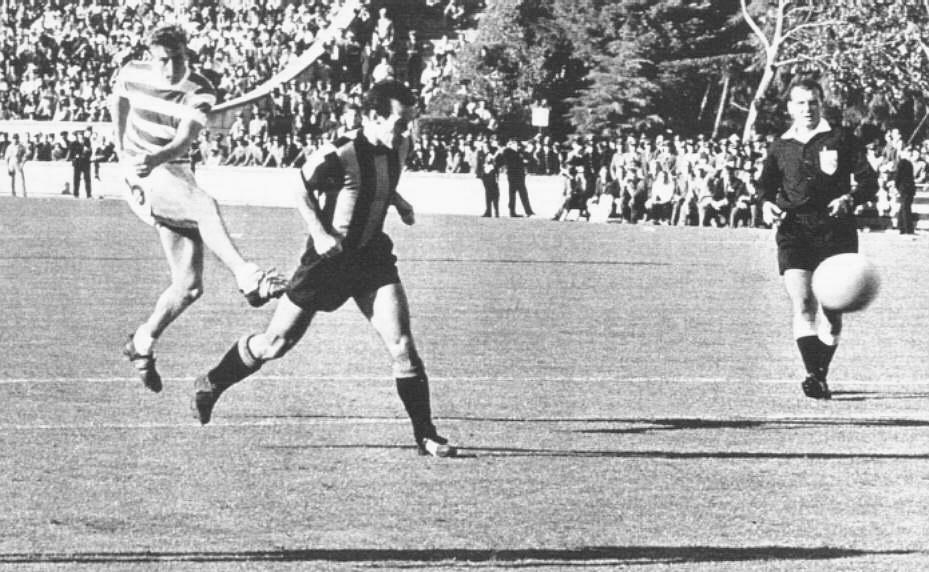
There’s a procession of near misses and great saves until, with just six minutes remaining, Celtic attack down the left wing, the side of the quaint temporary stand, where most of the Italians seem to have congregated. They will have a birds-eye view of Murdoch’s cross-cum-shot, which is diverted past the goalkeeper by the ever-alert Chalmers. It’s 2-1 to Celtic and “the European Cup is coming to Glasgow”.
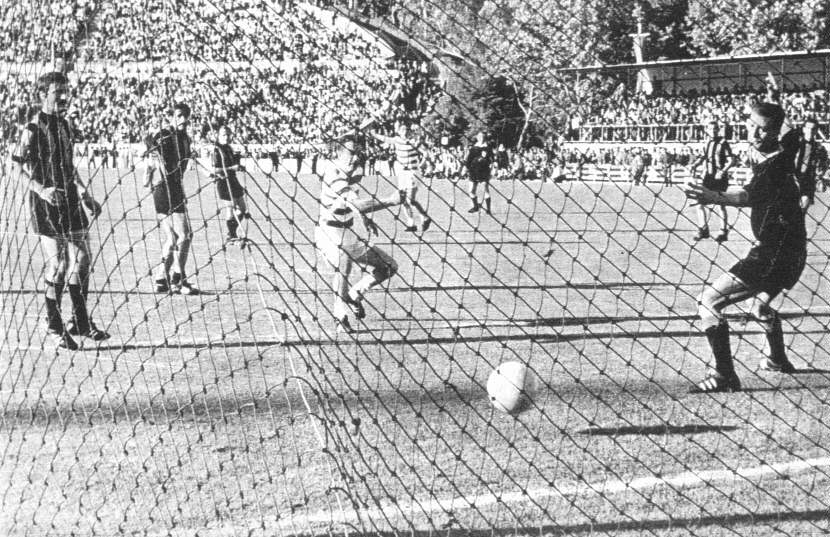
The remaining minutes are played out but the Italians are already a beaten side. The final blast of the German referee’s whistle signals a joyous invasion from the stands. The club founded less than eighty years earlier, to provide a means to feed the children of struggling families, have beaten Europe’s best to the biggest prize of all.
Eleven local men carrying the hopes and dreams of thousands back home have achieved the unachievable, winning all five competitions entered, now including the Big Cup.
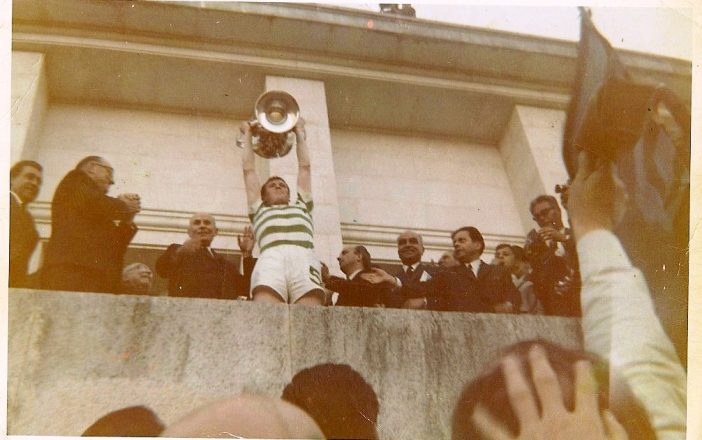
Things will never be quite the same again in the magical story that is Celtic Football Club.
The pupils have become the masters and the legend of the Lisbon Lions has been born.
Hail, hail!
Matt Corr



